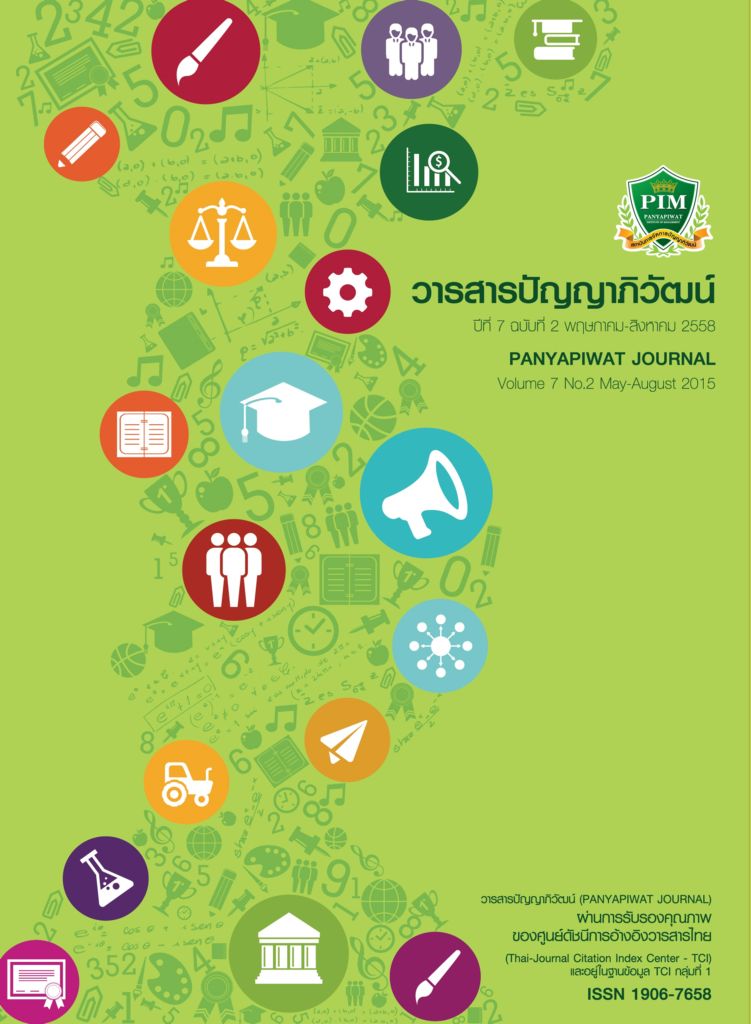ตัวแบบความผูกพันของพนักงานต่อองค์กร: กรณีศึกษาธุรกิจ บริการรับชำระบริษัท XYZ จำกัด
Main Article Content
บทคัดย่อ
บทคัดย่อ
การวิจัยนี้เป็นการวิจัยเชิงคุณภาพเก็บข้อมูลโดยการสัมภาษณ์แบบเจาะลึก (In-Depth Interview) และการสังเกตการปฏิบัติงานจากเป้าหมายที่เป็นตัวแทนพนักงานและผู้บริหารระดับต่างๆ จากหน่วยงานที่แตกต่างกันจำนวน 19 คน ผลการวิจัยพบว่า ตัวแบบการสร้างความผูกพันต่อองค์กรของธุรกิจบริการรับชำระบริษัท XYZ จำกัด ประกอบด้วย ส่วนแรก คือ ปัจจัยสร้างความผูกพัน (Engagement Drivers) จำนวน 4 ด้านประกอบด้วย 1) ด้านลักษณะงาน (Job Characteristics) 2) ด้านบุคคลและสังคมในองค์กร (People/Social) 3) ด้านระบบองค์กร (Organization Practice)
4) ด้านสภาพแวดล้อมขององค์กร (Organization Climate) ส่วนที่สอง คือ การแสดงออกถึงความผูกพันต่อองค์กรใน 2 มิติ คือ 1) ความรู้สึกผูกพัน (Feeling Engaged) และ 2) พฤติกรรมความผูกพัน (Behavior Engaged) และ ส่วนที่สาม คือ การแสดงผลลัพธ์ของความผูกพัน เป็นผลการปฏิบัติงานที่บรรลุเป้าหมาย ทั้งในระดับบุคคล ทีมงาน และองค์กร
องค์กรที่มีลักษณะงานใกล้เคียงกันสามารถนำปัจจัยนี้ไปวัดระดับความผูกพันและค้นหาปัจจัยสร้างความ
ผูกพันที่มีความสำคัญเฉพาะแต่ละองค์กร เพื่อนำไปพัฒนายกระดับความผูกพันให้สูงขึ้นได้
Abstract
This study is conducted in qualitative approach, collecting data by in-depth interview and performance observation on the targeted samples of 19 staffs and executives from various business units. The results showed that the organization’s engagement model of the bill payment service business is mainly comprised of 3 factors; engagement drivers, expression of engagement and business results. Engagement drivers are composed of 1) job characteristics 2) people and social3) organization practice and 4) organization climate, expression of engagement is composed of
1) feeling engaged and 2) behavior engaged and business results are performance achievement in individual level, team level and Organization level.
The similar organizations are able to apply this engagement model to evaluate engagement
and to obtain its significant engagement drivers to enhance employee engagement level ultimately.
Article Details
“ข้าพเจ้าและผู้เขียนร่วม (ถ้ามี) ขอรับรองว่า บทความที่เสนอมานี้ยังไม่เคยได้รับการตีพิมพ์และไม่ได้อยู่ระหว่างกระบวนการพิจารณาลงตีพิมพ์ในวารสารหรือแหล่งเผยแพร่อื่นใด ข้าพเจ้าและผู้เขียนร่วมยอมรับหลักเกณฑ์การพิจารณาต้นฉบับ ทั้งยินยอมให้กองบรรณาธิการมีสิทธิ์พิจารณาและตรวจแก้ต้นฉบับได้ตามที่เห็นสมควร พร้อมนี้ขอมอบลิขสิทธิ์บทความที่ได้รับการตีพิมพ์ให้แก่สถาบันการจัดการปัญญาภิวัฒน์หากมีการฟ้องร้องเรื่องการละเมิดลิขสิทธิ์เกี่ยวกับภาพ กราฟ ข้อความส่วนใดส่วนหนึ่งและ/หรือข้อคิดเห็นที่ปรากฏในบทความข้าพเจ้าและผู้เขียนร่วมยินยอมรับผิดชอบแต่เพียงฝ่ายเดียว”
เอกสารอ้างอิง
ธุรกิจบริการรับชำระ. (2557). เอกสารแนะนำธุรกิจบริการรับชำระ. กรุงเทพฯ: สำนักทรัพยากร บุคคล บริษัท XYZ จำกัด.
รางวัลคุณภาพแห่งชาติ. (ไม่ปรากฏปีที่พิมพ์). เกณฑ์คุณภําพเพื่อควํามเป็นเลิศ (TQA). สืบค้นเมื่อ 20 ธันวาคม 2557, จาก http://www.tqa.or.th
สำนักบริการวิชาการศูนย์ให้คำปรึกษาและพัฒนาทรัพยากรมนุษย์. สถาบันการจัดการปัญญาภิวัฒน์ PIM HR Excellence Center. (2557). การสร้ํางความผูกพันต่อองค์กร. กรุงเทพฯ: สำนักบริการวิชาการ.
Albrecht, S. L. (2010). Employee engagement: 10 Key questions for research and practice. In Albrecht, S. L. (ed.). Handbook of employee engagement: Perspectives, issues, research and practice. UK: Edward Elgar.
Armstrong, M. & Taylor, S. (2014). Armstrong’s handbook of human resource management practice. USA: Kogan Page Publishers.
Balain, S. & Sparrow, P. (2009). Engaged to perform: A new perspective on employee engagement: Academic report. Centre for Performance-led HR, Lancaster University Management School.
De Lacy, J. C. (2009). Employee engagement: The development of a three dimensional Model of engagement and an exploration of its relationship with affective leader behaviours. Queensland University of Technology.
Guest, D. E. & Conway, N. (2002). Communicating the psychological contract: An employer perspective. Human Resource Management Journal, 12(2), 22-38.
Harter, J. K. & Schmidt, F. L. (2008). Conceptual versus empirical distinctions among constructs: implications for discriminant validity. Industrial and Organizational Psychology, 1, 36–39.
Heskett, J. L. & Schlesinger, L. A. (1994). Putting the service-profit chain to work. Harvardbusiness review, 72(2), 164-174.
Herzberg, F. (1968). One more time: how do you motivate employees?. Harvard Business Review, 46, 53–62.
Hundley, S. P., Jacobs, F. & Drizin, M. (2007). Workforce engagement: Strategies to attract, motivate and retain talent. Washington, DC: World at Work Press.
Karson, R. & Kruse. F. (2011). WE: How to increase performance and profits through fullengagement. New Jersey: Wiley & Sons.
Kessler, S. & Bayliss, F. (1992). Contemporary British Industrial Relation. London: Macmillan.
Macey, W. H., Schneider, B., Barbera, K. & Young, S. A. (2009). Employee engagement: Toolsfor analysis, practice, and competitive advantage. London, England: Blackwell.
Maslow, A. H. (1970). Motivation and Personality. New York: Harper.
Perrin, T. (2006). Engaged employees help boost the bottom line. US: Towers Perrin-ISR. Society for Human Resources Management (2011) Module 3: Employee relation and communication. Florida: SHRM.
Translated Thai References
Bill payment service business. (2014). Introduction of bill payment Service business document. Bangkok: HR department of XYZ company limited. [in Thai]
HR Excellence Center. Panyapiwat institute of management (2014). Employee Engagement. Bangkok: Academic Service. [in Thai]
Thailand Qulity Award. (n.d.). Criteria for Performance Excellence(TQA). Retrieved December 20, 2014, form TQA website http://www.tqa.or.th[in Thai]


